Study on Dissipation Law of Pesticides in Cauliflower Based on Hyperspectral Image Technique
Abstract
:1. Introduction
2. Materials and Methods
2.1. Cauliflower Samples
2.2. Extraction of Spectral Data
2.3. Spectral Data Preprocessing
3. Results and Discussion
3.1. Model Selection
3.2. Dissipation Law of Pesticides
3.2.1. Pesticide Residues in Cauliflower Detected Using Chromatography
3.2.2. Pesticide Residues in Cauliflower Detected by the Hyperspectral Imaging Method
3.2.3. Comparison of Results of Hyperspectral Imaging Method and Chromatography
4. Conclusions
Author Contributions
Funding
Institutional Review Board Statement
Data Availability Statement
Conflicts of Interest
References
- Favela-González, K.M.; Hernández-Almanza, A.Y.; De la Fuente-Salcido, N.M. The value of bioactive compounds of cruciferous vegetables (Brassica) as antimicrobials and antioxidants: A review. J. Food Biochem. 2020, 44, 21. [Google Scholar] [CrossRef]
- Francisco, M.; Tortosa, M.; Martínez-Ballesta, M.D.; Velasco, P.; García-Viguera, C.; Moreno, D.A. Nutritional and phytochemical value of Brassica crops from the agri-food perspective. Ann. Appl. Biol. 2017, 170, 273–285. [Google Scholar] [CrossRef]
- Lo Scalzo, R.; Bianchi, G.; Genna, A.; Summa, C. Antioxidant properties and lipidic profile as quality indexes of cauliflower (Brassica oleracea L. var. botrytis) in relation to harvest time. Food Chem. 2007, 100, 1019–1025. [Google Scholar] [CrossRef]
- Jia, G.F.; Zeng, L.R.; Zhao, S.; Ge, S.J.; Long, X.F.; Zhang, Y.P.; Hu, D.Y. Monitoring residue levels and dietary risk assessment of pymetrozine for Chinese consumption of cauliflower. Biomed. Chromatogr. 2019, 33, 8. [Google Scholar] [CrossRef]
- Zhang, G.Y.; Tuo, X.G.; Zhai, S.; Zhu, X.M.; Luo, L.; Zeng, X.L. Near-Infrared Spectral Characteristic Extraction and Qualitative Analysis Method for Complex Multi-Component Mixtures Based on TRPCA-SVM. Sensors 2022, 22, 1654. [Google Scholar] [CrossRef]
- Bian, H.Y.; Yao, H.; Lin, G.H.; Yu, Y.S.; Chen, R.Q.; Wang, X.Y.; Ji, R.D.; Yang, X.; Zhu, T.Z.; Ju, Y.F. Multiple Kinds of Pesticides Detection Based on Back-Propagation Neural Network Analysis of Fluorescence Spectra. IEEE Photonics J. 2020, 12, 10. [Google Scholar] [CrossRef]
- Alsammarraie, F.K.; Lin, M.S. Using Standing Gold Nanorod Arrays as Surface-Enhanced Raman Spectroscopy (SERS) Substrates for Detection of Carbaryl Residues in Fruit Juice and Milk. J. Agric. Food Chem. 2017, 65, 666–674. [Google Scholar] [CrossRef]
- Jamshidi, B.; Mohajerani, E.; Jamshidi, J. Developing a Vis/NIR spectroscopic system for fast and non-destructive pesticide residue monitoring in agricultural product. Measurement 2016, 89, 1–6. [Google Scholar] [CrossRef]
- González-Martín, M.I.; Revilla, I.; Vivar-Quintana, A.M.; Salcedo, E.V.B. Pesticide residues in propolis from Spain and Chile. An approach using near infrared spectroscopy. Talanta 2017, 165, 533–539. [Google Scholar] [CrossRef] [PubMed]
- Ye, W.X.; Yan, T.Y.; Zhang, C.; Duan, L.; Chen, W.; Song, H.; Zhang, Y.F.; Xu, W.; Gao, P. Detection of Pesticide Residue Level in Grape Using Hyperspectral Imaging with Machine Learning. Foods 2022, 11, 1609. [Google Scholar] [CrossRef] [PubMed]
- Sun, J.; Hu, Y.; Zou, Y.L.; Geng, J.P.; Wu, Y.L.; Fan, R.S.; Kang, Z.L. Identification of pesticide residues on black tea by fluorescence hyperspectral technology combined with machine learning. Food Sci. Technol. 2022, 42, 9. [Google Scholar] [CrossRef]
- Jiang, R.C.; Gu, M.S.; Zhao, Q.H.; Li, X.R.; Shen, J.X.; Su, Z.B. Identification of Pesticide Residue Types in Chinese Cabbage Based on Hyperspectral and Convolutional Neural Network. Spectrosc. Spectr. Anal. 2022, 42, 1385–1392. [Google Scholar] [CrossRef]
- Hu, Y.T.; Ma, B.X.; Wang, H.T.; Zhang, Y.J.; Li, Y.J.; Yu, G.W. Detecting different pesticide residues on Hami melon surface using hyperspectral imaging combined with 1D-CNN and information fusion. Front. Plant Sci. 2023, 14, 15. [Google Scholar] [CrossRef] [PubMed]
- Zhang, M.Y.; Xue, J.X.; Li, Y.D.; Yin, J.Y.; Liu, Y.; Wang, K.; Li, Z.Z. Non-destructive detection and recognition of pesticide residue levels on cauliflowers using visible/near-infrared spectroscopy combined with chemometrics. J. Food Sci. 2023, 88, 4327–4342. [Google Scholar] [CrossRef]
- Nazarloo, A.S.; Sharabiani, V.R.; Gilandeh, Y.A.; Taghinezhad, E.; Szymanek, M.; Sprawka, M. Feasibility of Using VIS/NIR Spectroscopy and Multivariate Analysis for Pesticide Residue Detection in Tomatoes. Processes 2021, 9, 196. [Google Scholar] [CrossRef]
- Liu, H.S.; Zhang, Z.W.; Yang, Y.P.; Chen, T.; Zhang, C.L. Identification terahertz spectra for the dyestuffs based on principal component analysis and Savitzky-Golay filter. Optik 2018, 172, 668–673. [Google Scholar] [CrossRef]
- Chu, Y.W.; Tang, S.S.; Ma, S.X.; Ma, Y.Y.; Ha, Z.Q.; Gu, Y.M.; Gu, L.B.; Lu, Y.F.; Zeng, X.Y. Accuracy and stability improvement for meat species identification using multiplicative scatter correction and laser-induced breakdown spectroscopy. Opt. Express 2018, 26, 10119–10127. [Google Scholar] [CrossRef]
- Guo, Z.M.; Wang, M.M.; Barimah, A.O.; Chen, Q.S.; Li, H.H.; Shi, J.Y.; El-Seedi, H.R.; Zou, X.B. Label-free surface enhanced Raman scattering spectroscopy for discrimination and detection of dominant apple spoilage fungus. Int. J. Food Microbiol. 2021, 338, 9. [Google Scholar] [CrossRef]
- Su, W.H.; Sun, D.W.; He, J.G.; Zhang, L.B. Variation analysis in spectral indices of volatile chlorpyrifos and non-volatile imidacloprid in jujube (Ziziphus jujuba Mill.) using near-infrared hyperspectral imaging (NIR-HSI) and gas chromatograph-mass spectrometry (GC-MS). Comput. Electron. Agric. 2017, 139, 41–55. [Google Scholar] [CrossRef]
- Kumar, K. Competitive adaptive reweighted sampling assisted partial least square analysis of excitation-emission matrix fluorescence spectroscopic data sets of certain polycyclic aromatic hydrocarbons. Spectrochim. Acta Part A-Mol. Biomol. Spectrosc. 2021, 244, 8. [Google Scholar] [CrossRef]
- Li, H.D.; Liang, Y.Z.; Xu, Q.S.; Cao, D.S. Key wavelengths screening using competitive adaptive reweighted sampling method for multivariate calibration. Anal. Chim. Acta 2009, 648, 77–84. [Google Scholar] [CrossRef] [PubMed]
- He, J.; Zhang, C.; Zhou, L.; He, Y. Simultaneous determination of five micro-components in Chrysanthemum morifolium (Hangbaiju) using near-infrared hyperspectral imaging coupled with deep learning with wavelength selection. Infrared Phys. Technol. 2021, 116, 8. [Google Scholar] [CrossRef]
- Liu, W.J.; Liu, J.; Jiang, J.M.; Li, Y.J. Comparison of partial least squares-discriminant analysis, support vector machines and deep neural networks for spectrometric classification of seed vigour in a broad range of tree species. J. Near Infrared Spectrosc. 2021, 29, 33–41. [Google Scholar] [CrossRef]
- Galvao, R.K.H.; Araujo, M.C.U.; José, G.E.; Pontes, M.J.C.; Silva, E.C.; Saldanha, T.C.B. A method for calibration and validation subset partitioning. Talanta 2005, 67, 736–740. [Google Scholar] [CrossRef] [PubMed]
- Huang, Z.; Turner, B.J.; Dury, S.J.; Wallis, I.R.; Foley, W.J. Estimating foliage nitrogen concentration from HYMAP data using continuum removal analysis. Remote Sens. Environ. 2004, 93, 18–29. [Google Scholar] [CrossRef]
- Kanu, A.B. Recent developments in sample preparation techniques combined with high-performance liquid chromatography: A critical review. J. Chromatogr. A 2021, 1654, 21. [Google Scholar] [CrossRef] [PubMed]
- Zhu, F.L.; Zhang, D.R.; He, Y.; Liu, F.; Sun, D.W. Application of Visible and Near Infrared Hyperspectral Imaging to Differentiate Between Fresh and Frozen-Thawed Fish Fillets. Food Bioprocess Technol. 2013, 6, 2931–2937. [Google Scholar] [CrossRef]
- Saber, A.N.; Malhat, F.M.; Badawy, H.M.A.; Barakat, D.A. Dissipation dynamic, residue distribution and processing factor of hexythiazox in strawberry fruits under open field condition. Food Chem. 2016, 196, 1108–1116. [Google Scholar] [CrossRef]
- Heshmati, A.; Nili-Ahmadabadi, A.; Rahimi, A.; Vahidinia, A.; Taheri, M. Dissipation behavior and risk assessment of fungicide and insecticide residues in grape under open-field, storage and washing conditions. J. Clean. Prod. 2020, 270, 11. [Google Scholar] [CrossRef]
- Wang, X.Z.; Liu, J.H.; Chi, W.J.; Wang, W.G.; Ni, Y. Advances in Hyperspectral Image Classification Methods with Small Samples: A Review. Remote Sens. 2023, 15, 3795. [Google Scholar] [CrossRef]
- Tette, P.A.S.; Guidi, L.R.; Glória, M.B.D.; Fernandes, C. Pesticides in honey: A review on chromatographic analytical methods. Talanta 2016, 149, 124–141. [Google Scholar] [CrossRef] [PubMed]
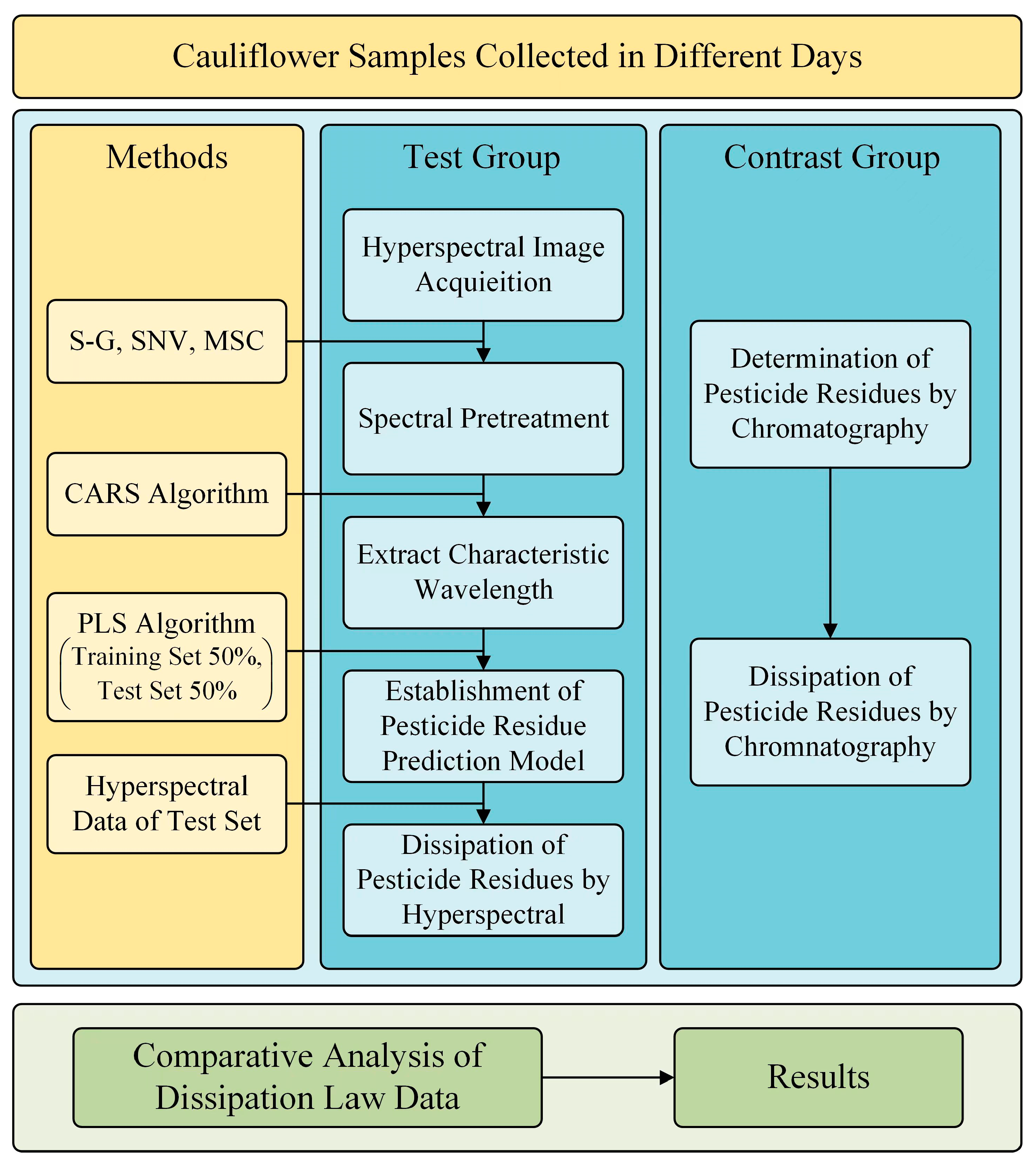
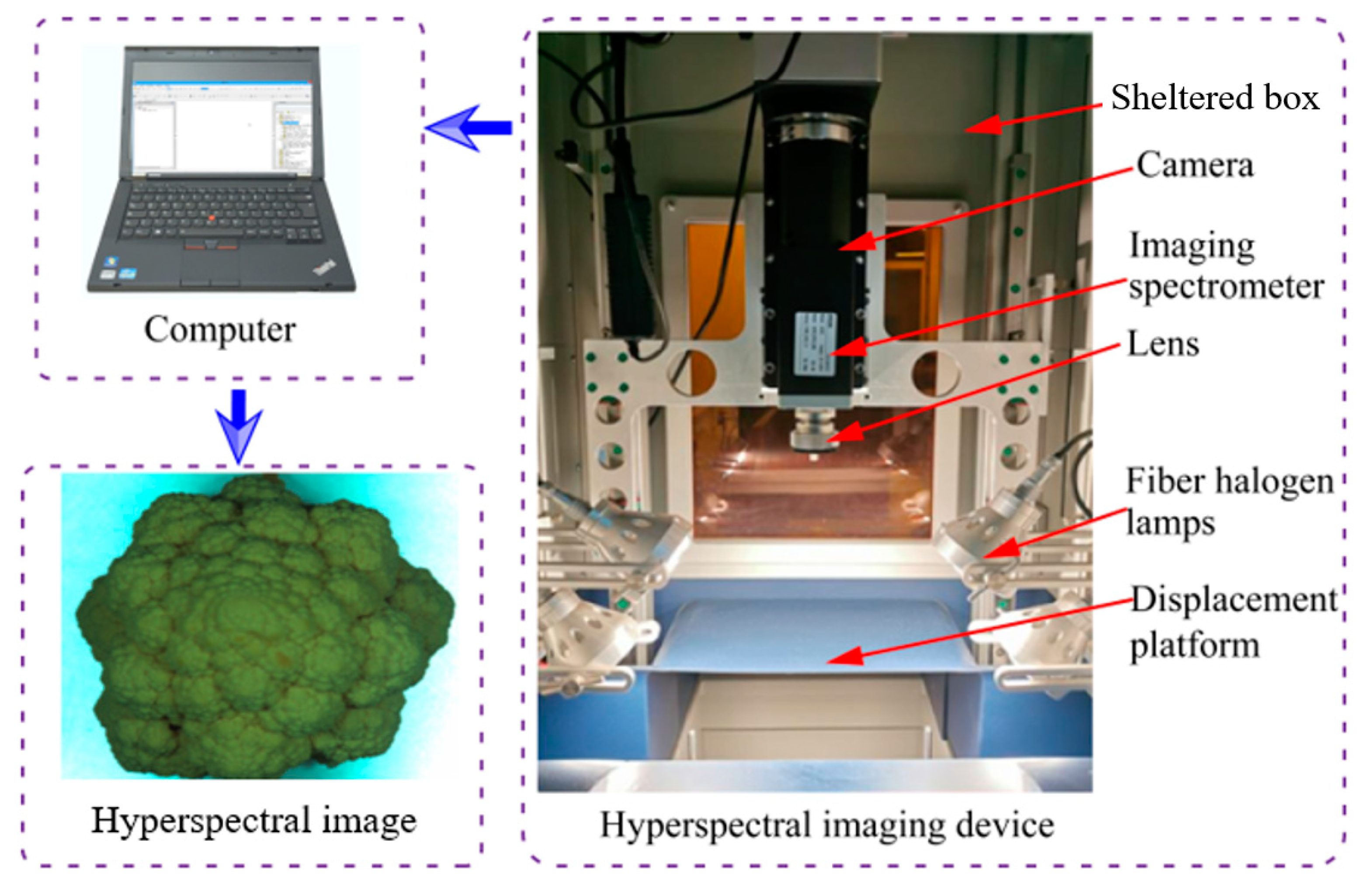
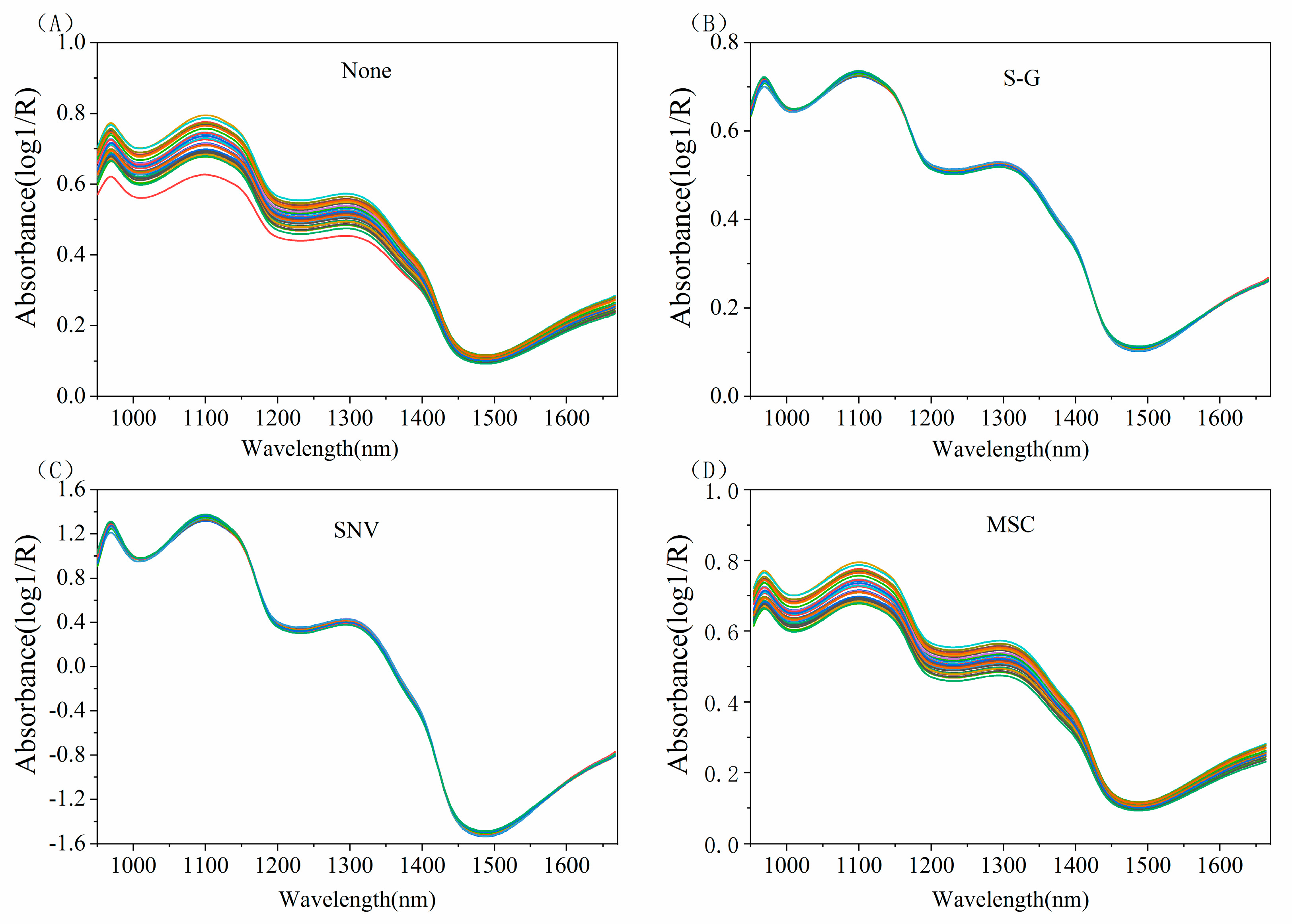
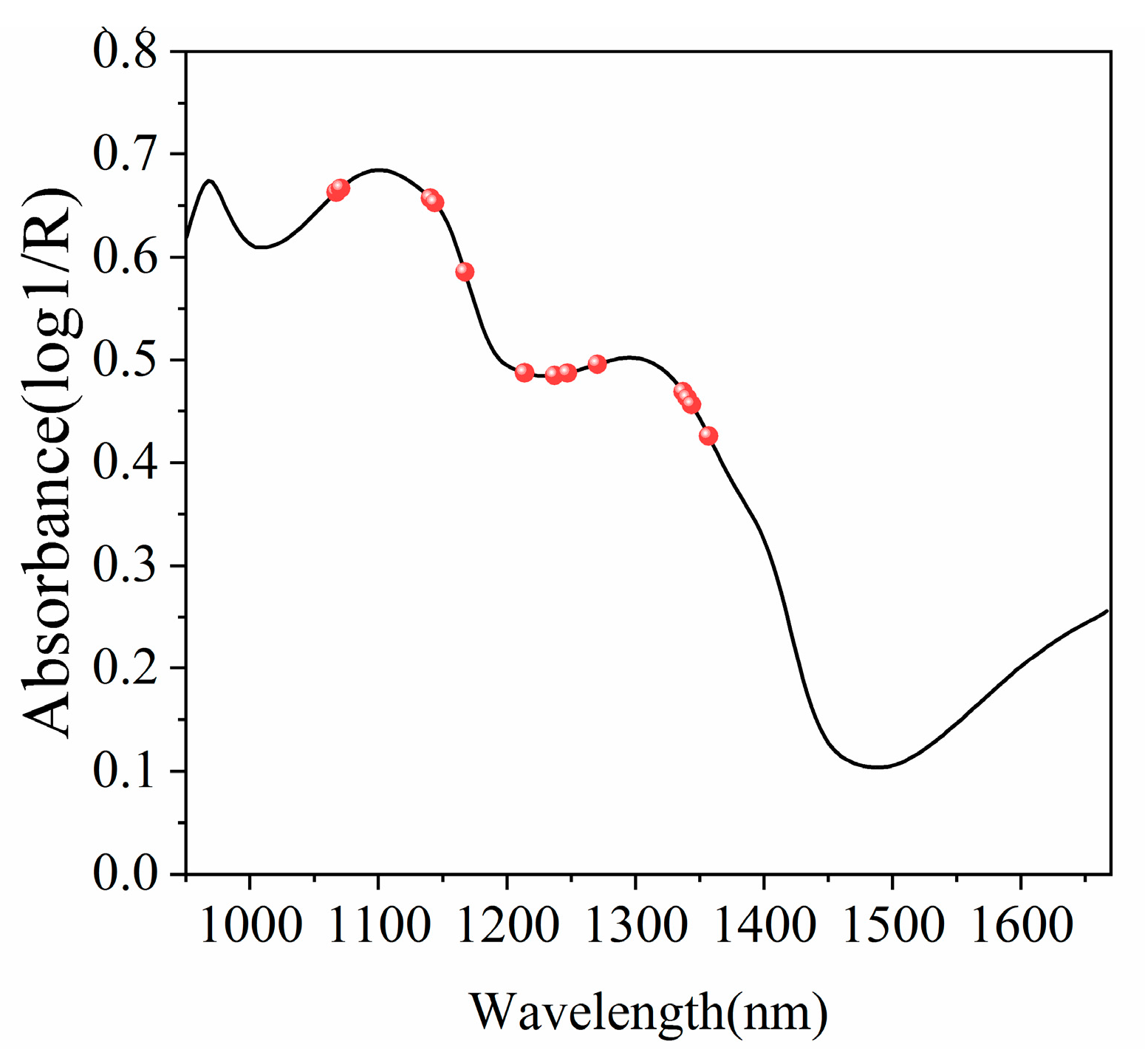
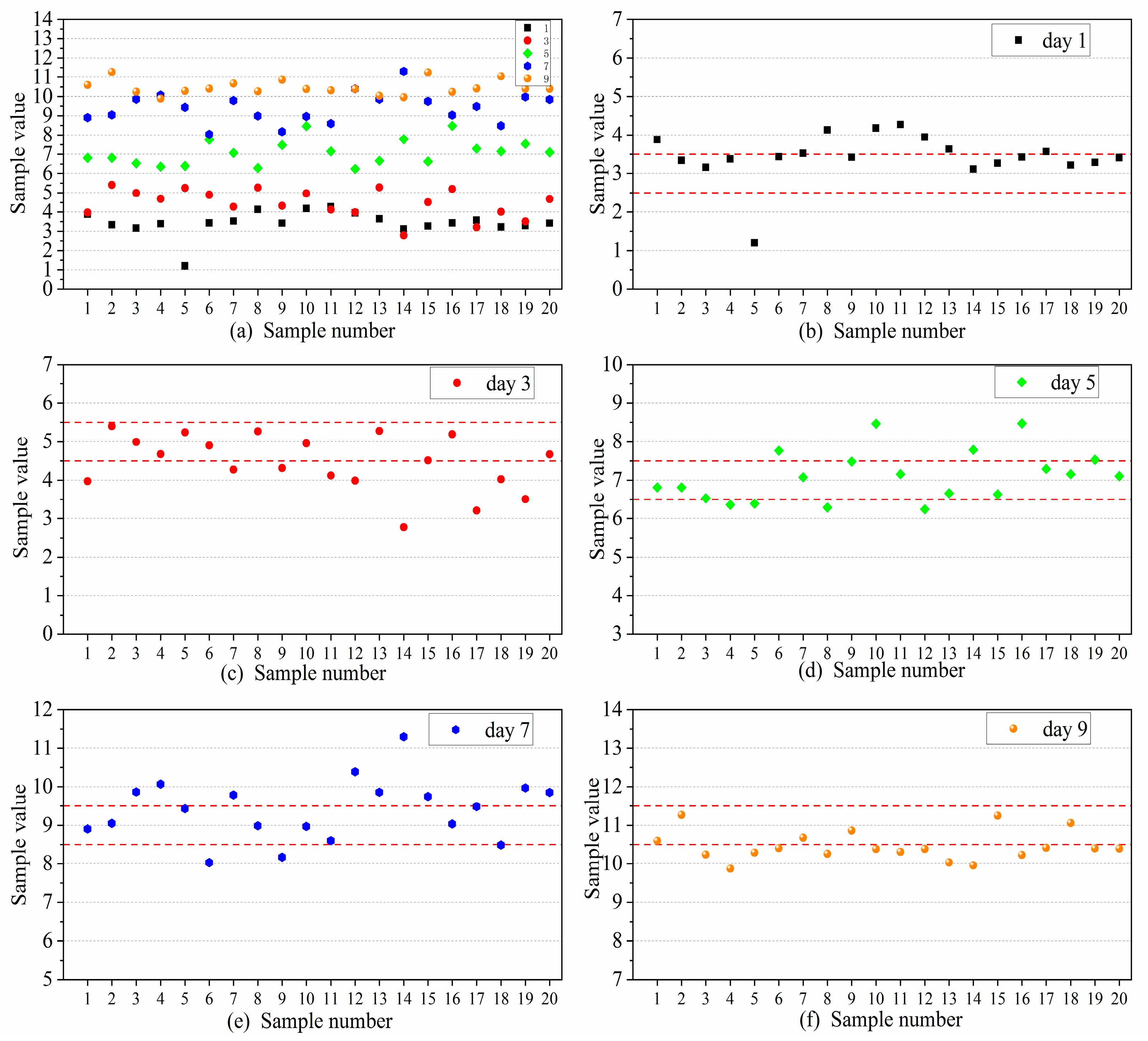
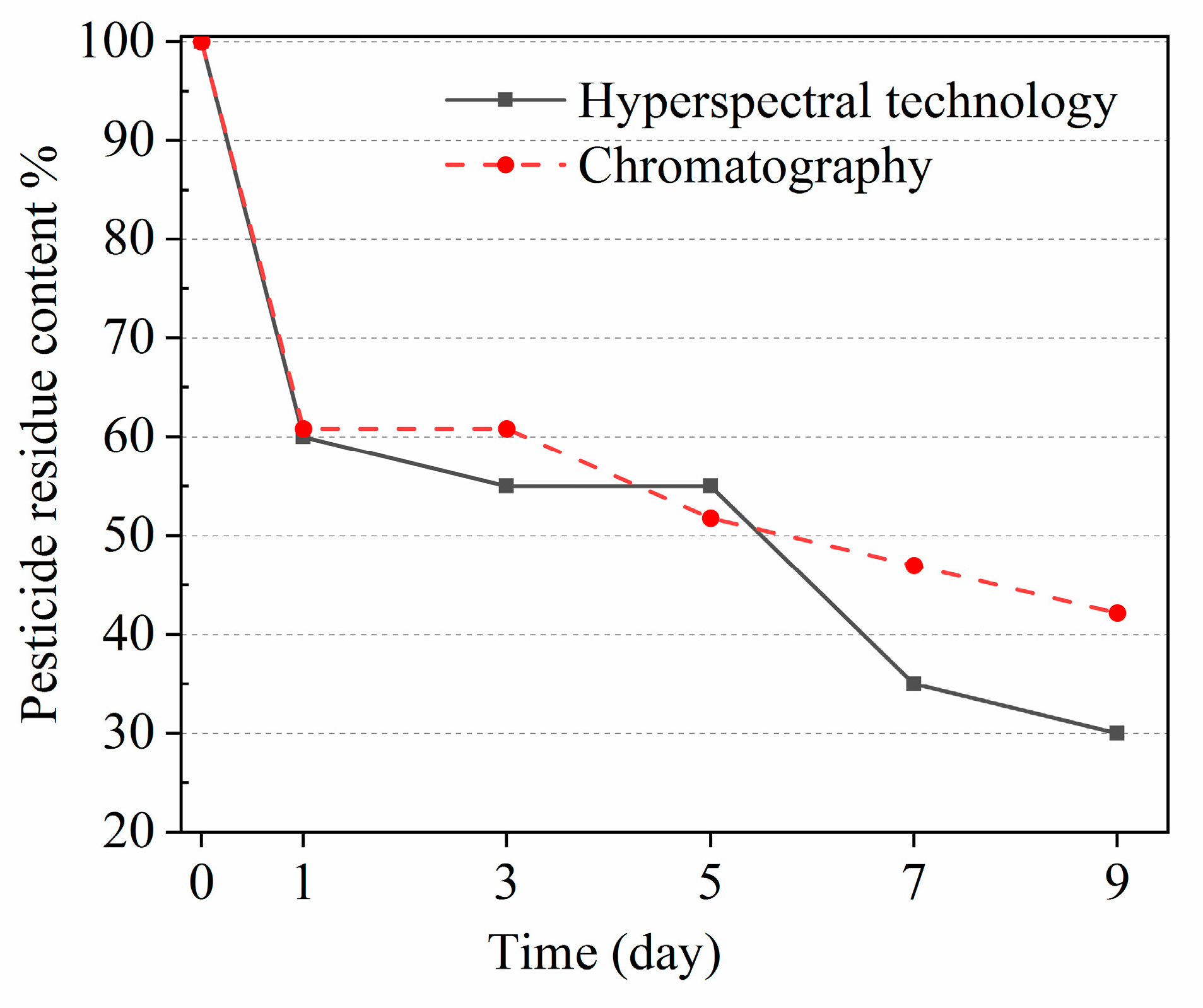

| Pretreatment Algorithm | Detection Rate of Pesticide Samples | Model Test Accuracy | |
|---|---|---|---|
| R2 | RMSE | ||
| None | 80 | 0.9247 | 0.4113 |
| S-G | 85 | 0.9678 | 0.2691 |
| MSC | 85 | 0.9673 | 0.2710 |
| SNV | 90 | 0.9688 | 0.2648 |
| Time (Day) | Emamectin Benzoate (mg/kg) | Indoxacarb (mg/kg) |
|---|---|---|
| 0 | 2.70 | 14.79 |
| 1 | 1.24 | 9.00 |
| 3 | 1.36 | 9.00 |
| 5 | 0.74 | 7.66 |
| 7 | 0.38 | 6.95 |
| 9 | 0.30 | 6.24 |
| Hyperspectral Imaging Technology | Chromatography | |
|---|---|---|
| Dissipation equation | Ct = 86.753 × 10−0.12271t | Ct = 14.105 × 10−0.12595t |
| Half-life t1/2 | 5.64 d | 5.5 d |
| R2 | 0.82118 | 0.93315 |
Disclaimer/Publisher’s Note: The statements, opinions and data contained in all publications are solely those of the individual author(s) and contributor(s) and not of MDPI and/or the editor(s). MDPI and/or the editor(s) disclaim responsibility for any injury to people or property resulting from any ideas, methods, instructions or products referred to in the content. |
© 2023 by the authors. Licensee MDPI, Basel, Switzerland. This article is an open access article distributed under the terms and conditions of the Creative Commons Attribution (CC BY) license (https://creativecommons.org/licenses/by/4.0/).
Share and Cite
Li, R.; Wang, H.; Shen, B.; Yao, X. Study on Dissipation Law of Pesticides in Cauliflower Based on Hyperspectral Image Technique. Agriculture 2023, 13, 2254. https://doi.org/10.3390/agriculture13122254
Li R, Wang H, Shen B, Yao X. Study on Dissipation Law of Pesticides in Cauliflower Based on Hyperspectral Image Technique. Agriculture. 2023; 13(12):2254. https://doi.org/10.3390/agriculture13122254
Chicago/Turabian StyleLi, Rui, Huaiwen Wang, Bingbing Shen, and Xingwei Yao. 2023. "Study on Dissipation Law of Pesticides in Cauliflower Based on Hyperspectral Image Technique" Agriculture 13, no. 12: 2254. https://doi.org/10.3390/agriculture13122254
APA StyleLi, R., Wang, H., Shen, B., & Yao, X. (2023). Study on Dissipation Law of Pesticides in Cauliflower Based on Hyperspectral Image Technique. Agriculture, 13(12), 2254. https://doi.org/10.3390/agriculture13122254






